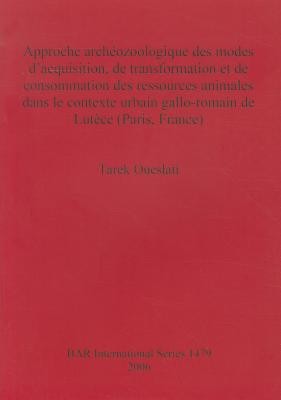
- We will send in 10–14 business days.
- Author: Tarek Oueslati
- Publisher: British Archaeological Reports Oxford Ltd
- ISBN-10: 1841719145
- ISBN-13: 9781841719146
- Format: 20.8 x 29 x 3.6 cm, minkšti viršeliai
- Language: English, Prancūzų
- SAVE -10% with code: EXTRA
Approche archéozoologique des modes d'acquisition, de transformation et de consommation des ressources animals dans le contexte urbain gallo-romain de Lutèce (Paris, France) (e-book) (used book) | bookbook.eu
Reviews
Description
This volume presents a zooarchaeological study of eleven Gallo-Roman bone assemblages retrieved over the past fifteen years from rescue excavations in Paris. The Roman occupation of 'Lutecia' is divided into four periods (1st c. BC - 4th c AD). The limits of the antique city on the left bank of the Seine are situated within the 5th and 6th districts of today's city of Paris. Only a restricted area of the right bank is occupied. Two Necropolises are known and are located at the south and south east of these limits. Until now, no Iron-age occupation has been found under the Roman city. Eight of the studied assemblages are habitat contexts, two are located in dump areas of the city, and the last specialized in ceramic production. The finds help to improve our understanding of Gallo-Roman society while emphasizing the influence of the conquest on native peoples. Considerable progress has been made towards a more comprehensive understanding of the provisioning of urban contexts, the hierarchy of food and the status of consumers. In addition, light is shed on some aspects of butchery and meat redistribution and the post-conquest orientation of agriculture. This work increases the resolution of zooarchaeology in the analysis of antique societies and these advances will further increase the interest of classical archaeology in the collection and study of animal bones.
EXTRA 10 % discount with code: EXTRA
The promotion ends in 23d.20:08:13
The discount code is valid when purchasing from 10 €. Discounts do not stack.
- Author: Tarek Oueslati
- Publisher: British Archaeological Reports Oxford Ltd
- ISBN-10: 1841719145
- ISBN-13: 9781841719146
- Format: 20.8 x 29 x 3.6 cm, minkšti viršeliai
- Language: English, Prancūzų English, Prancūzų
This volume presents a zooarchaeological study of eleven Gallo-Roman bone assemblages retrieved over the past fifteen years from rescue excavations in Paris. The Roman occupation of 'Lutecia' is divided into four periods (1st c. BC - 4th c AD). The limits of the antique city on the left bank of the Seine are situated within the 5th and 6th districts of today's city of Paris. Only a restricted area of the right bank is occupied. Two Necropolises are known and are located at the south and south east of these limits. Until now, no Iron-age occupation has been found under the Roman city. Eight of the studied assemblages are habitat contexts, two are located in dump areas of the city, and the last specialized in ceramic production. The finds help to improve our understanding of Gallo-Roman society while emphasizing the influence of the conquest on native peoples. Considerable progress has been made towards a more comprehensive understanding of the provisioning of urban contexts, the hierarchy of food and the status of consumers. In addition, light is shed on some aspects of butchery and meat redistribution and the post-conquest orientation of agriculture. This work increases the resolution of zooarchaeology in the analysis of antique societies and these advances will further increase the interest of classical archaeology in the collection and study of animal bones.


Reviews